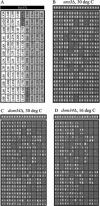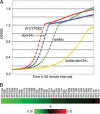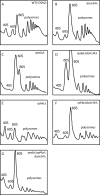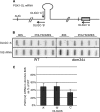Why Dom34 stimulates growth of cells with defects of 40S ribosomal subunit biosynthesis
- PMID: 20876302
- PMCID: PMC2976434
- DOI: 10.1128/MCB.00618-10
Why Dom34 stimulates growth of cells with defects of 40S ribosomal subunit biosynthesis
Abstract
A set of genome-wide screens for proteins whose absence exacerbates growth defects due to pseudo-haploinsufficiency of ribosomal proteins in Saccharomyces cerevisiae identified Dom34 as being particularly important for cell growth when there is a deficit of 40S ribosomal subunits. In contrast, strains with a deficit of 60S ribosomal proteins were largely insensitive to the loss of Dom34. The slow growth of cells lacking Dom34 and haploinsufficient for a protein of the 40S subunit is caused by a severe shortage of 40S subunits available for translation initiation due to a combination of three effects: (i) the natural deficiency of 40S subunits due to defective synthesis, (ii) the sequestration of 40S subunits due to the large accumulation of free 60S subunits, and (iii) the accumulation of ribosomes "stuck" in a distinct 80S form, insensitive to the Mg(2+) concentration, and at least temporarily unavailable for further translation. Our data suggest that these stuck ribosomes have neither mRNA nor tRNA. We postulate, based on our results and on previously published work, that the stuck ribosomes arise because of the lack of Dom34, which normally resolves a ribosome stalled due to insufficient tRNAs, to structural problems with its mRNA, or to a defect in the ribosome itself.
Figures







Similar articles
-
Small and Large Ribosomal Subunit Deficiencies Lead to Distinct Gene Expression Signatures that Reflect Cellular Growth Rate.Mol Cell. 2019 Jan 3;73(1):36-47.e10. doi: 10.1016/j.molcel.2018.10.032. Epub 2018 Nov 29. Mol Cell. 2019. PMID: 30503772 Free PMC article.
-
Immature small ribosomal subunits can engage in translation initiation in Saccharomyces cerevisiae.EMBO J. 2010 Jan 6;29(1):80-92. doi: 10.1038/emboj.2009.307. Epub 2009 Nov 5. EMBO J. 2010. PMID: 19893492 Free PMC article.
-
Dom34:hbs1 plays a general role in quality-control systems by dissociation of a stalled ribosome at the 3' end of aberrant mRNA.Mol Cell. 2012 May 25;46(4):518-29. doi: 10.1016/j.molcel.2012.03.013. Epub 2012 Apr 11. Mol Cell. 2012. PMID: 22503425
-
Assembly of the small ribosomal subunit in yeast: mechanism and regulation.RNA. 2018 Jul;24(7):881-891. doi: 10.1261/rna.066985.118. Epub 2018 Apr 30. RNA. 2018. PMID: 29712726 Free PMC article. Review.
-
Selective footprinting of 40S and 80S ribosome subpopulations (Sel-TCP-seq) to study translation and its control.Nat Protoc. 2022 Oct;17(10):2139-2187. doi: 10.1038/s41596-022-00708-4. Epub 2022 Jul 22. Nat Protoc. 2022. PMID: 35869369 Review.
Cited by
-
Translation drives mRNA quality control.Nat Struct Mol Biol. 2012 Jun 5;19(6):594-601. doi: 10.1038/nsmb.2301. Nat Struct Mol Biol. 2012. PMID: 22664987 Free PMC article.
-
Recent structural studies on Dom34/aPelota and Hbs1/aEF1α: important factors for solving general problems of ribosomal stall in translation.Biophysics (Nagoya-shi). 2013 Sep 7;9:131-40. doi: 10.2142/biophysics.9.131. eCollection 2013. Biophysics (Nagoya-shi). 2013. PMID: 27493551 Free PMC article. Review.
-
Dom34-Hbs1 mediated dissociation of inactive 80S ribosomes promotes restart of translation after stress.EMBO J. 2014 Feb 3;33(3):265-76. doi: 10.1002/embj.201386123. Epub 2014 Jan 14. EMBO J. 2014. PMID: 24424461 Free PMC article.
-
Inside the 40S ribosome assembly machinery.Curr Opin Chem Biol. 2011 Oct;15(5):657-63. doi: 10.1016/j.cbpa.2011.07.023. Epub 2011 Aug 20. Curr Opin Chem Biol. 2011. PMID: 21862385 Free PMC article. Review.
-
Disruption in iron homeostasis and impaired activity of iron-sulfur cluster containing proteins in the yeast model of Shwachman-Diamond syndrome.Cell Biosci. 2020 Sep 11;10:105. doi: 10.1186/s13578-020-00468-2. eCollection 2020. Cell Biosci. 2020. PMID: 32944219 Free PMC article.
References
-
- Costanzo, M., A. Baryshnikova, J. Bellay, Y. Kim, E. D. Spear, C. S. Sevier, H. Ding, J. L. Koh, K. Toufighi, S. Mostafavi, J. Prinz, R. P. St. Onge, B. VanderSluis, T. Makhnevych, F. J. Vizeacoumar, S. Alizadeh, S. Bahr, R. L. Brost, Y. Chen, M. Cokol, R. Deshpande, Z. Li, Z. Y. Lin, W. Liang, M. Marback, J. Paw, B. J. San Luis, E. Shuteriqi, A. H. Tong, N. van Dyke, I. M. Wallace, J. A. Whitney, M. T. Weirauch, G. Zhong, H. Zhu, W. A. Houry, M. Brudno, S. Ragibizadeh, B. Papp, C. Pal, F. P. Roth, G. Giaever, C. Nislow, O. G. Troyanskaya, H. Bussey, G. D. Bader, A. C. Gingras, Q. D. Morris, P. M. Kim, C. A. Kaiser, C. L. Myers, B. J. Andrews, and C. Boone. 2010. The genetic landscape of a cell. Science 327:425-431. - PMC - PubMed
Publication types
MeSH terms
Substances
Grants and funding
LinkOut - more resources
Full Text Sources
Other Literature Sources
Molecular Biology Databases
